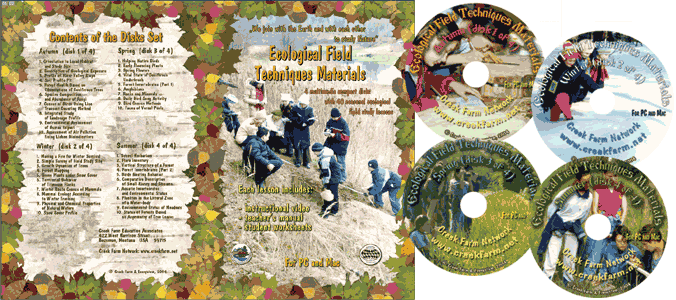|
| Our Field Ecology Center published more than
180 methodical materials for nature studies. Some of them are in English: |
|
|
|
Procedure of Winter Mammals Route Census by Footprints
© Alexsander S. Bogolyubov,
Russia, 1999
© Michael J. Brody, USA,
2003
 This manual contains a standard procedure of
census for large and middle-sized mammals (from weasel to elk) during a winter period,
which is applied in the system game animals' census in the forested zone of Russia. This
manual includes a description of census routes selection procedure, technique of census
data processing and calculation of numbers of animals per unit of the area. This manual contains a standard procedure of
census for large and middle-sized mammals (from weasel to elk) during a winter period,
which is applied in the system game animals' census in the forested zone of Russia. This
manual includes a description of census routes selection procedure, technique of census
data processing and calculation of numbers of animals per unit of the area.
This field study has instructional video
featuring real students conducting the ecological field techniques in nature. Each video
illustrates the primary instructional outcomes and the major steps in accomplishing the
task including reporting the results.
Introduction
The educational task described here leads to students individual route census of
animals using footprints left by mammals on snow cover during winter. According to the
task, several censuses are made separately in three or four types of habitats most typical
for your area.
This work is not too laborious, however, it requires the skill to recognize animal
species by their footprints, skills to get orientated and to measure distances on
location, as well as skiing ability.
Main idea of procedure of winter mammals route census by footprints
In Russia the winter route census is applied to an estimation of population
density and numbers of average and large mammals on large territories. It is also
used with scientific research purposes within the venatic (venatorial,
hunting) system.
The procedure of winter route census is based on estimations that the average
number of mammal footprints crossing a registration route is directly proportional to this
species' population density. Whereas a number of footprints within the area depends on
activity of animal migrations (movements): the probability of finding animal footprints en
route is higher the more active the animal is and the more it migrates.
Thus, in order to estimate the species' population density (number of specimens
per unit of the area) two parameters are required: 1) an average of footprint crossings
made by an animal per a time unit (for example, per one day) per unit of route length and
2) a coefficient connected with mobile activity (length of a daily course) of the given
animal.
In a simple example, the formula of population density estimation based on the data
from counting footprints as D = A K, where D equals the given species' population density
(number of animals per unit of the area within the territory), A equals census value
(average of footprint crossings made by animals of a certain species during one day per a
unit of route length), and K equals conversion factor, connected with length of a daily
course of the animal during the census period in the given territory.
In this connection, the census procedure consists of two parts: 1) determination of
"A" value, i.e. direct route counting 2) estimation of conversion factor K.
The conversion factor can be determined by one of the following methods: 1) by tracking
animalsТ footprints with the subsequent estimation of an average length of a daily
course, 2) by comparison of a census value with an animalsТ population density on the
test sites; thus the number of animals on test sites is defined by the method of multiday
encirclement.
In order to calculate the conversion factor correctly, it is necessary to use
the information on an average length of a daily course of animals received by various
methods in different years in different regions. It is very time-consuming work;
therefore, nowadays the calculation of conversion factors is carried out only by state
statistic organizations. In Table 2 (see at the end of this manual) the average values of
factors for the majority of animal species inhabiting forested zones of Russia calculated
for three main climatic zones based on the research data in 1991-1994 are indicated.
These factors can be used for the purposes of the given educational task only in the
case that similar factors of animalsТ daily activity for your area are not available.
Census procedure
Conditions of census
The main condition of a winter route census is the presence of snow cover, on which
animals leave their footprints.
Census taking is not carried out during a period of hard frosts, long thaws, in a
period when ice crust is formed on the snow surface, or during days with a strong wind,
snowfall or drifting snow. Thus, a census does not take place during days with "extreme"
weather conditions. After a heavy snowfall the census is not carried out for 2-3 days.
If a strong snowfall or blizzard starts after footprints have been cleaned from the
route or while a census is being taken, the census stops and should be carried out again
when...
This was only the first page from the manual and its full version you can see in the
Ecological Field Studies Techniques Video 4CD Set:
It is possible to purchase the complete set of 40 seasonal Ecological Field
Studies Techniques Video (in mpg format) in an attractive 4 compact disk set.
These compact disks are compatible with Mac and PC computers.
The videos are suitable for individual student or whole class instruction. To purchase the complete 4CD set
write to ecosystema1994@yandex.ru in a free form.

Ecological Field Studies Demo Disk:
We also have a free and interesting demonstration disk that explains our ecological field studies approach.
The demo disk has short excerpts from all the seasonal field study videos as well as sample text from all the teacher manuals.
The disk has an entertaining automatic walk through which describes the field study approach and explains how field studies meet education standards.
You can also download the Demo Disc from ecosystema.ru/eng/eftm/CD_Demo.iso.
This is a virtual hybrid (for PC and Mac computers) CD-ROM image (one 563 Mb file "CD_Demo.iso").
You can write this image to the CD and use it in your computer in ordinary way.
You also can use emulator software of virtual CD-ROM drive to play the disk directly from your hard disk.

|







